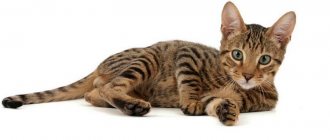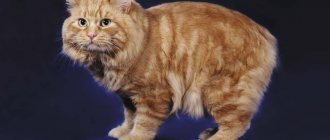Brief history of the breed
This breed originated in Great Britain in 1981. Her story began with an accidental mating of a Burmese cat of the English Baroness Miranda von Kirchberg and a luxurious chinchilla-colored Persian.
After the news of what happened, the hostess could not come to her senses for a long time. But after the appearance of the most beautiful kittens, the baroness decided to start breeding a new breed called Burmilla. Soon the result of her work aroused the interest of local nursery owners. Thanks to joint efforts, in 1990 the Burmilla was awarded champion status.
Breeding
Since this breed is relatively young and rare, the main difficulty in breeding is finding a suitable mating partner. A true Burmilla that will meet the standard cannot be obtained by simply crossing a Persian and a Burmese, as Mrs. Kirchberg did. The characteristics of the breed will fully manifest themselves only in the 5th–6th generation.
Puberty in cats occurs at 6–8 months, but they cannot be bred that early. The appropriate age for first mating is 12–15 months. A healthy cat that meets the approved standard and has experience of sexual activity should be considered as a partner. Before mating, it is necessary to undergo tests and genetic tests so that the offspring do not have health problems.
Castration and sterilization are resorted to by those who do not want to engage in cat breeding. The procedure is carried out when the pet is 7–8 months old. It is done under general anesthesia, the recovery period lasts 5–7 days.
In nurseries you can buy pet class animals, which due to shortcomings in the exterior cannot become producers. Breeders castrate them at an early age. Such animals are bought for keeping.
Breed description, standards, appearance
The Burmese Silver is an elegant, proportionally built cat with graceful movements and well-developed muscles. A detailed description of the breed is presented in the official standard.
Dimensions and weight
Burmillas are medium-sized cats, they grow up to 25-30 cm at the withers. Sexual dimorphism is weakly expressed in the breed, so the weight of females and males is almost the same. The average weight of an adult Silver Burmese ranges from 4-6 kg.
Anatomical characteristics
A typical Burmilla cat should fit the following description:
- The head is medium-sized, rounded, smoothly contoured, with a short, wide muzzle and pronounced cheeks.
- The nose is small, with a pink nose.
- The eyes are large, expressive, widely set, with a black rim and an oriental cut. The shape resembles a crescent. The Burmilla's iris can be green or amber. Juvenile Burmese silvers are allowed to have bright orange eyes.
- The ears are medium in size, set wide apart, with a slight tilt forward.
- The body is strong, proportionally built, with developed muscles, a small woolly hump on the nape and a long, smoothly tapering tail.
- The limbs are spindle-shaped, muscular, with round paws and black pads. The hind legs of the Silver Burmese are longer than the front ones.
Color and coat type
Depending on the length of the guard hair, there are 2 varieties in the breed:
- Burmilla shorthair;
- longhaired burmilla.
The former have airy, fluffy fur, which gives them a resemblance to Persians. They were registered 10 years later than the shorthaired representatives of the breed and are better known as the Australian Tiffany.
Although Burmilla coat colors are very diverse, they are all very similar to each other. The main color of the fur is silver-white, and on the sides, head and back of the cat there is chocolate, blue, cream, red, lilac or caramel color.
Important! The Burmilla's belly, neck and chest are always white, and the tail, paws and muzzle are silvery. On the cat's forehead there is a pattern in the shape of the letter M.
Possible breed defects
According to the generally accepted standard, the following are considered exterior flaws:
- striped points on the paws;
- excessively long limbs;
- short body;
- a long nose;
- poorly developed chin;
- hump on the bridge of the nose;
- shaggy or elongated hair in short-haired individuals.
Colors
Burmilla always - whether an individual with short or long hair - has a delicate silver-white background, on which the rest of the colors are already “superimposed”.
According to the standard, these can be:
- Cream;
- Caramel;
- Blue;
- Lilac;
- Red;
- Brown;
- Chocolate;
- Black.
Allowed types of colors:
- Black or chocolate “haze”;
- Muted brown, muted lilac;
- Tortoiseshell British;
- Solid cream, solid black;
- Brindle (speckled blue or black).
Silver and chinchilla are the only colors recognized by the WCF system.
Character and temperament
Burmillas are affectionate and devoted animals; they quickly become attached to people and do not tolerate loneliness well. Cats are very sociable and express emotions with muted, non-irritating meows. Silver Burmese are moderately active and playful, but are not predisposed to destructive activities.
Due to their non-aggressive nature, Burmillas get along well with children. They will never scratch or bite even an overly intrusive child, but will prefer to avoid contact with him.
Silver Burmese easily get along with other pets. But if they feel that they are being deprived of attention, they begin to be jealous.
Health
Burmillas are distinguished by good health, they have almost no hereditary diseases. The exception is polycystic kidney disease, inherited from Persians. This is a disease in which the renal parenchyma is replaced by cysts, gradually impairing the functions of the organ. There is no effective therapy against this pathology. At the initial stages, surgical operations are performed in which the altered area of the kidney with the cyst is removed. In the later stages, even these measures do not work. After such a diagnosis, a pet can live only a few months.
You can read more about kidney disease in cats
Healthy and sick kidney
Another pathology that Burmillas inherited from their “paternal” line is cardiomyopathy. The danger of this disease is that the heart muscle stops contracting normally. As a result, organs suffer from a lack of oxygen and nutrients. This causes disruptions in the functioning of the entire body. Drug therapy occupies the main place in treatment.
Attention! Due to their susceptibility to polycystic disease and cardiomyopathy, cats should be examined regularly by a veterinarian. This will prolong the life of pets.
Video - How is polycystic kidney disease treated in cats?
How to choose the right kitten
The Burmilla is a cat that is one of the ten rarest breeds due to its difficulty in breeding. Therefore, its purchase should be approached with maximum responsibility. It is better to purchase a Burmese silver kitten from a certified nursery that takes care of maintaining the breed lines.
When choosing a future pet, it is important to pay attention to:
- for the availability of documents;
- compliance with breed standards;
- behavior;
- health status.
Kitten care
A Burmilla kitten learns basic self-care skills from its mother. Therefore, it is better to pick him up from the breeder after he is 3 months old. To begin with, the baby is allowed to get used to the changed conditions and shown where his bowls, tray, place to sleep and scratching post are located.
To prevent accidents from happening to the kitten while getting to know the new home, houseplants, detergents, wires and breakable objects are removed from the kitten in advance. Also, for safety reasons, Burmilla's access to large household appliances, open balconies and windows is limited.
At first, the kitten is fed what the breeder gave. This will help avoid digestive problems, which often develop due to stress and sudden changes in diet. New products are added to the Burmese silver's menu gradually to observe the reaction of the animal's body. Depending on the age, the kitten is fed 6 to 3 times a day.
How much does a Burmilla cost?
The price for a pet-class Burmilla cat is 32-55 thousand rubles. The price for highly elite representatives of this breed sometimes reaches 75 thousand rubles.
This price can be explained by the fact that this cat breed is incredibly difficult to breed, and there are very few such nurseries in Russia.
We are sure that you liked this article and you learned a lot of useful information today. Next you can look at a large selection of photos of the Burmilla cat. We wish you all the best!
Care and maintenance
Despite their “aristocratic” origin, Burmilla are unpretentious to living conditions and easily adapt to life in a city apartment. In general, caring for cats of this breed is simple and includes several mandatory hygiene procedures:
- The Burmilla's ears are cleaned weekly to remove any accumulations of dust and dirt. Each of them is instilled with a special agent, and then treated with a cotton pad.
- The cat's eyes are wiped daily with a piece of natural fabric soaked in herbal infusion or boiled water.
- The Silver Burmese's teeth are regularly cleaned of plaque using a soft brush and non-foaming toothpaste.
- The cat's claws are trimmed as needed with a nail clipper, and only the transparent ends are removed.
- The shorthaired Burmilla's coat is combed once a week. Fluffy cats of this breed are scratched every other day.
- They bathe the Silver Burmese no more than once a quarter. To prevent the cat from catching a cold, after bathing procedures it is thoroughly dried with a terry towel and dried with a hairdryer.
Diseases
Burmilla, despite its external fragility, has fairly good health. However, any interference with nature reduces natural immunity. That is why purebred cats have much more specific diseases than ordinary “Barsiks” and “Muroks”.
But even if the cat lives inside the house and doesn’t go outside for walks, it still needs vaccinations! The owner can carry germs on his own clothes or shoes, and then his pet will have a hard time. Before each vaccination it is necessary to drive away worms!
According to veterinarians, there are no characteristic diseases in Burmillas, but sometimes a pathology such as polycystic kidney disease is transmitted in the hereditary “baggage”.
With this disease, multiple cysts grow in the kidneys of cats. They fill with fluid, gradually affecting both kidneys and causing gradual intoxication of the body. Treatment cannot be delayed, since the disease, although it does not cause immediate death, is extremely painful. A complete cure is impossible, but it is quite possible to stop development and give the animal a few more years of life.
Expert opinion
Dusheba Vera Ivanovna
In 2010, she graduated from the Moscow State Academy of Veterinary Medicine named after K.I. Scriabin with honors, specializing in veterinary medicine. I regularly attend veterinary conferences, congresses, and webinars.
If you are planning breeding, remember: “mating” Burmilla with individuals of other breeds leads to the loss of dominant characteristics. Suitable age for mating: 14-16 months. It is not recommended to breed cats younger than this age: since the bones of the “young animals” are not strong enough, the cat will develop a deflection of the spine (from a heavy belly), and the birth itself will be difficult. If you don’t need offspring, don’t be lazy and take your pet for castration (sterilization). In Burmillas, unlike many other breeds, sexual activity lasts throughout the year; a spree can begin at any time. Think: is it worth torturing both the animal and yourself? The operation is permitted from 1.5 years.
Feeding the cat
For proper development and good health, the Burmilla needs adequate nutrition. It is most convenient to feed such a cat with premium or super premium dry food. When choosing food, you should pay attention to the following brands:
- Farmina;
- Pronature;
- Grandorf;
- Brit Care.
All of them meet international quality standards and do not contain questionable additives.
With a natural type of nutrition, sources of animal protein should predominate in the Burmilla’s diet. In addition to meat, the cat is given:
- porridge;
- offal;
- vegetables;
- ocean fish;
- eggs;
- sour milk.
In order not to harm the health of the Burmilla, pork, baked goods, sweets, smoked meats and sausages are excluded from its diet. Also, the cat is not given fresh milk, exotic fruits, bones, river fish or any food from the owner’s table.
Dietary recommendations
A Burmilla cat should eat well – get enough protein, vitamins, and amino acids. Then she will be beautiful and healthy. Veterinarians and felinologists recommend feeding purebred pets with super-premium or holistic industrial food.
Those who prefer a natural menu will have to learn how to properly prepare their diet. Almost 80% of the total amount of food a cat receives is poultry, rabbit, beef, and veal. Pork is fatty, it is better to avoid it. About 20% of the diet is supplements in the form of vegetables, cereals, eggs, and dairy products. Sometimes you can pamper your pet with a piece of mild and lightly salted cheese. Liver is given once a week, like fish. Preference should be given to the inhabitants of the deep sea, they contain fatty acids.
Kittens are fed 3-4 times a day, adult Burmilla - morning and evening
Prohibited products:
- fatty, fried, spicy foods;
- sweets, baked goods, bread;
- potato;
- beans;
- whole milk;
- smoked meats;
- salty snacks, dried fish;
- mushrooms;
- bones.
Vaccinations and antiparasitic treatment
Even exclusively kept at home is not a guarantee that the Burmilla will not become a victim of viral or infectious diseases. Therefore, for the purpose of prevention, the cat is subjected to routine vaccination against rhinotracheitis, calcivirosis and panleukopenia.
The first Burmese silver vaccination is given at the age of 7-8 weeks. After 28 days, the kitten is vaccinated again, but with an anti-rabies component. In the future, the Burmese silver is vaccinated once a year.
To prevent diseases transmitted by fleas and worms, the cat is systematically subjected to antiparasitic treatment. Medicines for Burmese silverback helminths are given twice a year with mandatory repetition after 10-14 days. To combat external parasites, collars, drops and shampoos are used.
Origin
The Burmilla is considered a relatively young breed; it dates back to the 80s of the last century. The homeland of these majestic beauties is Great Britain. One baroness named Miranda Bickford-Smith doted on cats and was breeding two breeds - Persian and Burmese. On the woman's estate, a separate room was allocated for each of these varieties, which was locked to prevent communication between the Persians and the Burmese.
But one day the maid forgot to close the door with the Burmese and one of the cats ran free. At this time, the baroness was giving her friend a gift in the form of a Persian cat. The man was going to castrate him immediately, but the cat, as if sensing something was wrong, ran away from his new owner.
The meeting between a Burmese beauty and a Persian cat took place in the backyard. When the baroness and her friend were missed, it was already too late - the mating had happened.
The woman was angry with the maid and was even going to drive her away. But after a while, kittens of amazing beauty were born. When they grew up a little, the Baroness noted their docile and affectionate nature, unlike the Persians.
Due to the fact that the cat, which miraculously escaped castration, was of the “Persian chinchilla” breed and chinchilla coat color, it was decided to combine the names “Burmese” and “Persian chinchilla”, which ultimately gave birth to a new breed - the Burmilla.
Pros and cons of the breed
By analogy with cats of other breeds, the Silver Burmese has not only advantages, but also disadvantages:
| pros | Minuses |
| Beautiful appearance | Rarity of the breed |
| Equilibrium | High price |
| Undemanding |
Burmillas are attractive cats with an affectionate, sociable disposition. They do not like to be left alone for long periods of time and are ideal for large families with children.
Walk
To maintain good physical shape, your cat needs a walk. You can't let her go alone - she can only go for walks accompanied by her owner, on a harness. Choose dry, clear weather without wind if you want to take your pet out.
Burmilla cat on the walk
It’s good if you have your own yard, your pet will like it there. Just keep in mind - Burmillas love to explore every corner of their domain. Sometimes they get so carried away that they leave the area.
Advice. To prevent your pet from leaving the yard, you can install an anti-cat system on the top of the fence. This is a rotating structure that prevents the animal from grabbing the edge and jumping over the fence.
Advantages
They are incredibly elegant and miniature, so admiring them is a pleasure. Cats have a cheerful and cheerful character and love to spend time with their owner.
Burmillas are cats with wonderful personalities. They took all the best from their parents. Animals are distinguished by their friendliness and easy-going disposition. They can show aggression towards new pets, but gradually get used to them and treat them just as calmly.
Even in adulthood, cats will not lie on the sofa; they remain cheerful and playful. They love children very much and tolerate all their antics. They are calm about water procedures and nail trimming.
They will never demand food or impose their attention. However, they will try to be in the center of events
The only drawback can be considered the inability of Burmilla cats to tolerate loneliness. Therefore, this breed is not suitable for people who are often away from home. It is possible to have two cats at once, then they will not get bored entertaining each other.
Important! Constant loneliness can lead to depression and mental disorders in an animal
Burmilla retains its cheerfulness and playfulness into old age











